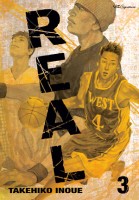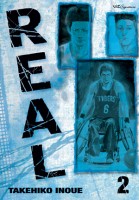 Creator: Takehiko Inoue
Creator: Takehiko Inoue
U.S. publisher: Viz Media
ISBN: 9781421519913
Released: January 2009
Original release: 2003
Awards: Japan Media Arts Award
Takehiko Inoue is probably best known for his basketball manga series Slam Dunk. Now, I enjoy Slam Dunk quite a bit. However, it’s another basketball manga by Inoue that is my personal favorite—Real, which specifically features wheelchair basketball. Although Real and Slam Dunk both share some similar themes, Inoue’s approach in Real tends to be much more serious and realistic, which make sense as the series is intended for a more mature audience. Real began serialization in the manga magazine Weekly Young Jump in 2001. Later that year, Inoue would win a Japan Media Arts Award Excellence Prize for the manga. The third volume of Real was released in Japan in 2003. Viz Media published Real under its Signature imprint, releasing the English-language edition of Real, Volume 3 in 2009. Real is a fantastic series that starts strongly and only continues to get stronger with each volume.
Things always came easily for Takahashi and he naturally excelled at both school and sports. But now he is faced with one of the most daunting challenges of his life. The question is whether or not he will be able to meet that challenge. After being hit by a truck, Takahashi has lost all feeling in his legs along with his ability to walk. He is in complete denial about his condition and is convinced that with only a little effort he’ll be back to playing basketball in no time. Takahashi is in for quite a shock when he begins his physical rehabilitation and he doesnt’ take it well. Recovery, both mental and physical, will be a long and excruciating process and in the end Takahashi will never have the mobility he once enjoyed. Coming to terms with that fact and facing reality are the first steps that Takahashi needs to take in order to move on with his life, but they may be some of the most difficult ones to accomplish.
Although Takahashi is largely the focus of the third volume of Real, he is not the only one who is facing a significant crossroads in his life. Moving forward after a traumatic experience is one of the themes addressed in Real, Volume 3. Nomiya still feels incredibly guilty over the accident that he was in which caused Natsumi to lose the use of her legs. She, like Takahashi, has begun her rehabilitation. It’s a painful and exhausting process for the body, the mind, and the spirit. Seeing this, Nomiya desperately wants to change the direction his life is heading and to become a better person. This, too, is not an easy process. At this point in the series, Togawa serves as proof that these sorts of challenges can be overcome. Things certainly aren’t perfect for him and he still harbors intense anger and frustration, but even with a missing leg he leads a full life. However, it took hard work and effort to get to where he is now. Whether or not Takahashi will be able to do the same remains to be seen.
One of the things that impresses me about Real and Inoue’s work in general is his ability to create incredibly flawed characters who are still sympathetic. Takahashi in particular can be extremely harsh and unlikeable, but I still care about him and his situation. His tormented feelings over no longer being able to walk and how he believes that makes him a lesser person are counterproductive. But he is not the only person who shares them; others struggle with those types of feelings as well. Tamura, the captain of Togawa’s basketball team, has repeatedly expressed similar sentiments which either deflates the other players or pisses them off. (Togawa is particularly sensitive to this issue and has hauled off and punched Tamura at least once because of it.) Inoue’s adept handling of these concerns, while specific to the context of Real and its characters, is also more universally applicable. Almost everyone, no matter who they are, has experienced feelings of inadequacy and disappointment at some point in their lives. Real simply shows what can happen when that reality is faced head on.








